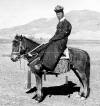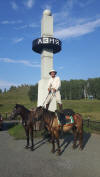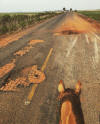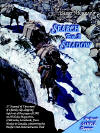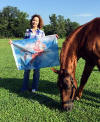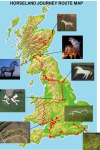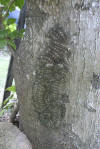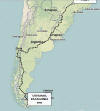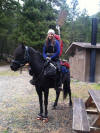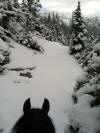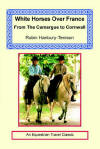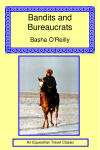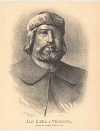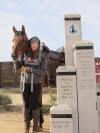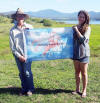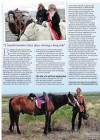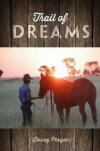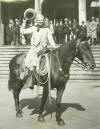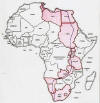Equestrian Freedom or Political Repression?
Millions of people around the world are justifiably frightened. A savage war in Syria continues to slaughter helpless civilians. Europe is being torn apart by violent civic unrest. Resurgent dictators threaten the liberty of weaker nations. The American presidential election invoked a sense of global apprehension. A special “Word from the Founder” urges humanity to remember that our oldest ally, the horse, has a part to play, for good or evil, in the days to come. As Long Rider history proves, the horse can be a messenger of liberty or a tool of tyrants.
Rare film shows Long Riders crossing Tibet in 1942
In the spring of 1942 the Japanese had
conquered the eastern portion of the previously impregnable British Empire.
With India threatened, and their allies in China surrounded by hostile
Japanese forces, Roosevelt and Churchill hatched the idea of using the
mountainous kingdom of Tibet as a transit station for supplies to be moved
overland from India to China.
Enter the most unlikely Long Rider in Tibet’s long history, the dashing
Count Ilya Tolstoy,
a grandson of the famous Russian author. Accompanying Tolstoy was
Captain Brooke Dolan,
a brilliant Princeton University naturalist turned US army spy. Their
mission was simple. Go to India. Find horses. Ride over the Himalayas to
Lhasa without getting killed. Introduce themselves to the Dalai Lama. Entice
him to become a diplomatic ally. Then ride on to China before reporting back
to Washington DC.
After surviving many adventures, Tolstoy wrote a detailed story about the remarkable ride, which includes a photo of a mounted Tibetan aristocrat (right). Dolan survived the journey but was later killed in combat. What was not known was that before his death, Dolan also recorded his version of events in a film entitled Inside Tibet.
Unfortunately, because the film had been created for America’s Office of Strategic Services, the precursor to the modern CIA, Dolan’s unique contribution to Tibetan and Long Rider history was classified as secret and remained effectively lost for many decades. Thanks to Roger Croston, a British scholar who studies Tibetan history, this unique film was rediscovered and may be viewed on You Tube.
The colour movie shows the Long Riders travelling across India and Tibet. It includes astonishing footage of the unspoiled countryside and depicts beautiful palaces which have since been destroyed. Plus, the equestrian information is incredible. The girthless Oriental pack saddle is clearly depicted being used by pack horses in Dolan’s caravan. Additionally, there is a stunning sequence involving the Tibetan national cavalry. And there is even footage of a Tibetan Appaloosa horse!
Lithuanian Long Rider Travels to Asia
Restless equestrian traveller Vaidotas Digaitis has made another remarkable journey. The Lithuanian Long Rider has already made two important trips. In 2010 Vaidotas participated in what has been called Lithuania’s Riding Renaissance, when he journeyed 2,000 kilometres (1,250 miles) from the Baltic to the Black Sea. In 2012 Vaidotas became the first Long Rider to reach the Arctic Circle since the 1950s. During this 6,000 kilometre (3,700 miles) journey, Vaidotas began the ride at his home in the village of Laukuva, Lithuania. He crossed Russia (Kaliningrad), Poland, Germany, Denmark, Sweden, reached the Arctic Circle and then rode home.
When Vaidotas recently set on his third journey, he once again used Žemaitukai horses. These Lithuanian horses are famous for being strong travellers. In the company of his two horses, Azuolas and Ceklis, Vaidotas rode 3,000 kilometres (1,800 miles) from Lithuania, across Russia, over the Ural Mountains and into Asia. The photo shows him at the point where Europe meets Asia. The journey was concluded at Surmenevsky, in the district of Chelyabinsk
Long Riders meet during historic trip
Vyv Wood-Gee continues to link up Great Britain’s equestrian past. The route of the 2,400 kilometre (1,500 miles) journey is the first to connect eight white horses carved into the country’s hillsides. Having reached southern England, Vyv was greeted by another equestrian pioneer. Mounted on his horse, Strider, Long Rider William Reddaway recently completed the first journey to thirty of Great Britain’s historic cathedrals and abbeys.
Trouble while riding to the End of the World
Filipe Leite, who is on a journey from Brazil to Patagonia, has ridden 2,200 kilometres (1,370 miles). In addition to enduring serious illness, Filipe had to travel along a terrible road.
“I have never seen a main road in such a horrific state. Some of the holes looked like they were created by meteors. If a car was to hit one of these craters at full speed, it would most certainly mean serious injury for those inside or even death.”
Despite the adversity, Filipe wrote, “It’s great to know that although I am riding alone out here, there are fellow Long Riders all over the world blazing their own trails. Distance and time may separate our physical beings but the saddle and our love for the horse unites our souls. We all ride together. Long live the Long Riders Guild.”
A Demonstration of Equestrian Ethics
The Guild would like to welcome Katrina Littlechild as a new Associate Member. When she set off in the company of her horse, Cognac, their goal was to ride from John O’Groats, Scotland to Land’s End, England. Though Katrina had ridden nearly one thousand miles, this exemplary Long Rider prematurely concluded her journey just short of her goal rather than imperil the welfare of her horse.
“After looking at all our options, I didn't feel I could make him comfortable enough to continue, so I made the difficult decision to take him home and rest him for a good few months.”
Long Riders collectively realize that accidents occur to our horses without premeditation or warning. In such a case the Guild requires that the journey be halted so as to allow the horse the time it needs to heal. Katrina’s decision to put Cognac’s welfare before her ego is a strong demonstration of sterling equestrian ethics. Welcome to the Guild, Long Rider.
Solo in Siberia!
New Zealand Long Rider Ian Robinson has already completed some of the most
inspiring equestrian journeys in this new century. He began his equestrian
explorations by riding alone across Mongolia. Ian next crossed Tibet
by riding from east to west. During that journey he was
chased by
communist police,
who were determined to capture him. More recently Ian explored the
Wakhan
Corridor
of Afghanistan. He has now set off on the first modern equestrian
exploration of Siberia, a feat last done by Cossack Long Rider
Alexandra
Kudasheva in
1913. In a message sent to the Guild, Ian explained that he has already
encountered one of the many bears that inhabit this sparsely populated
region.
"I have reached a lake called Lybunkur, about 80 kilometres south of the
village of Tomtor from where I set out. The going has been slow as the
terrain is very rugged, very wet, and there are swampy places which are
impossible to ride across. The area is also virtually uninhabited."
The image shows Ian with his Yakut horse, Katchula. This marks the first
time the
Guild flag
has been carried in Russia.
Chasing Fame from the Saddle
For nearly a century they were known
as the
Forgotten Heroes
of equestrian travel. A ground-breaking investigation has now brought them
out of the shadows of the past.
“In 1915, four young men arrived on
horseback at the towering gates of the Panama-Pacific International
Exposition in San Francisco. They were dressed in their finest cowboy duds
and had even given their horses a good bath and brushing before they
arrived. The men sat tall in their saddle as they walked their horses
through the crowded thoroughfare, a shaggy black dog trotting behind them.
They had good reason to promenade – they were taking the final steps of an
unprecedented equestrian journey. The riders were on their last dollar, road
weary, and homesick, but nonetheless optimistic. “
Thus begins an enthralling
investigation into one of the most significant equestrian journeys in
history, the 20,000 mile ride done by George Beck (right) and his three
companions.
Samantha Szesciorka
is uniquely qualified to write this overdue academic study. A journalist,
film producer and museum curator, Samantha is also an avid Long Rider who is
currently making her second equestrian journey in the USA.
Because she had personally experienced
hardships in the saddle during her first ride, Samantha brought an
exceptional perspective to what became an intensive two-year investigation.
In addition to studying equestrian travel history and reviewing newspaper
archives, she went to the
Bainbridge Historical Museum, where she inspected George Beck’s
diaries. The resulting doctorial thesis provides more than a mere recounting
of where four men rode to. Samantha is the first academic to discover and
decipher points about the Overland Westerners which have eluded previous
queries. Her most startling deduction is connected to the mystery of why,
even though they had spent three years in saddle riding 20,352 miles, the
Long Riders were ignored by the press and forgotten by the public.
America, Samantha deduced, was a
“changing nation” in 1915.
“Why did others manage to achieve a
modicum of fame? I think the answer lies in the way America re-embraced the
symbolism of the West,” she wrote.
Beck and his friends dreamed of fame and never found it. A century after
that journey’s tragic end, Samantha has written a “Story
from the Road”
that asks us to consider what price we will pay in order to achieve that
mirage called “celebrity.”
Tips on Equestrian Travel with Children
With the aid of a riding horse and two pack burros, Eliza Allen and her ten-year-old daughter, Zaydee Kiagoes, set off to make a 3,500 mile journey along Australia’s Bicentennial National Trail. Having completed half the trip, Eliza has written a valuable “Story from the Road” explaining how parents can travel safely successfully with children.
Historic family journey recalled in new book
In April, 1969 Barry Murray, his wife and three young children set off on a journey that was to become a Long Rider legend. The Murrays were determined to be the first family to ride the length of the Pacific Crest Trail. In his book, Search for a Shadow , Barry explains how the group rode 4,286 kilometres (2,663 miles) from Mexico to Canada. Barry Jr. was 12 when the journey began. Bernadette was 10 and Colette 8. The Murray family reached the Canadian border in October, 1970. In the subsequent decades the PCT has become increasingly popular. But as the new book explains, it was thanks to the Murray’s pioneering efforts that portions of the trail were built.
Ride across the desert to help Wild Horses
Samantha Szesciorka doesn’t just talk
about protecting mustangs. She is riding a thousand mile journey through the
Nevada desert country
to demonstrate the incredible stamina of these legendary horses. Sage is the
nine-year-old mustang who is accompanying Samantha.
“When you’re moving at three miles per hour, you see everything. You really
get to know a place when you go through it on a horse,” Samantha told a
Nevada newspaper.
Guild Flag to Accomplish Historic Journey
Lisa Stewart (right) is one of
America’s most dedicated Long Riders. After riding more than 3,000 miles
across the USA in the early 1980s, Lisa helped launch one of that country's
most successful saddle companies. She is the author of a special study
entitled
Saddling in
the 21st Century
and has continued to explore the nation on her horse, Chief. Thanks to her
years in the saddle, her miles on the road and her knowledge of travel, Lisa
responded to a request to act as the mentor for a historically significant
ride.
A handful of men have ridden to all 48 American states, the most celebrated
being the
Overland Westerners.
Yet no woman has ever attempted this rigorous multi-year trip. Meredith
Cherry is preparing to become the first woman to try. Her
Centauride
will begin shortly. Lisa, who is acting as Meredith’s mentor, is seen
holding the Guild flag that will be carried on the journey. This flag was
previously carried by Bernice Ende, who recently completed the first ride
across the United States in both directions on the same journey.
The Lost Sea Expedition inspires documentary
Some Long Riders, such as
Bernice Ende,
are so enchanted by equestrian travel that they make multiple journeys by
horseback. Only a few, such as
Lee Young,
leave the saddle and become avid wagon travellers.
Bernie Harberts
is another Long Rider. He not only made an “ocean to ocean”
ride across the USA, he then travelled by wagon from Canada to Mexico. The
Lost Sea Expedition
is a documentary film which recounts how Bernie made a 2,500 mile journey to
rediscover the lost sea that once existed in the centre of the North
American continent. With the help of his small mule, Polly, the trip crossed
ten states.
“Out there in my tiny wagon, I filmed what I lived: tumbleweed gales, snow
storms, the highs of Badlands Blue and the low of Prairie Fever. I lived
among the people I interviewed; ranchers, Lakota elders, scientists,
creationists and every day folks,” Bernie informed the Guild.
For those who wish to emulate Bernie’s mode of travel,
The Wagon Travel Handbook
is the finest book ever penned about modern wagon travel.
First “Ocean to Ocean” Ride in Both Directions Completed
The Guild has offered its "congratulations" to some remarkable men and women, who completed many a challenging journey in diverse and dangerous countries all over the world. But this is the first time we have ever congratulated someone for having opened an entirely new page in equestrian travel history.
The first person known to have ridden “ocean to ocean” was Willard Glazier, who rode from the Atlantic to the Pacific in 1875. In 1911 Two Gun Nan Aspinwall became the first woman to ride “ocean to ocean.” Hundreds of Long Riders have repeated the journey, in both directions, in the intervening decades. Yet no one had ever ridden “ocean to ocean” in both directions on the same journey - until now.
Bernice Ende had ridden 35,500 kilometres (22,000 miles) during seven consecutive journeys in the United States and Canada. Yet this was to be her biggest challenge. In the company of her two Fjords, Essie Pearl and Montana Spirit, Bernice set off from her home in Montana. The team reached the Atlantic Ocean on October 8, 2015. After wintering over on the East coast Bernice resumed riding. She reached the Pacific Ocean (top) on June 17, 2016. By the time she rode back to Montana, Bernice had been in the saddle for two and a half years and had ridden 8,000 miles.
Long Rider history is filled with examples of travellers who drew inspiration from others. Bernice is no exception. Having entitled her journey “From Suffragettes to Lady Long Riders,” this mounted champion of female liberty carried a message in honour of all those women who sacrificed so much in the cause of freedom. When she reached New York, Bernice made a special pilgrimage to the grave of Susan B. Anthony, one of the early champions of women’s rights (bottom).
Due to the historic nature of this journey, the Guild has placed Bernice in the LRG Records.
To learn more about Bernice’s “ocean to ocean” ride, visit her website.
And the Long Riders’ Guild would like to issue a special thanks to Russ Barnett, owner of Outfitters Supply. This company has provided top quality equestrian travel equipment at the very best prices to Long Riders for years. But beyond that, Russ and his staff have been instrumental in helping bring about the renaissance of modern equestrian travel by providing emotional support to Bernice and many other Long Riders. We urge you to visit and support this fine and trusted company:
Exploring Britain's horse history on horseback
Having previously ridden from John O’Groats in Scotland to Land’s End in Cornwall, Long Rider Vyv Wood-Gee knows her way around great Britain. She has now departed on a unique new journey. Her goal is to ride to eight of the enigmatic white horses carved into Britain's hillsides.
Vyv began her journey at Scotland’s only white horse hill figure; the Mormond white horse north of Strichen. From there Vyv rode south to the Kilburn white horse carved into the Yorkshire Moors. She will also visit the Uffington white horse, which was carved 3000 years ago. Wherever possible she is following routes historically used by pack ponies, pit ponies, Reivers, Romans and others in the days when horse were the main means of transport. The journey is being documented on Vyv’s blog and via Facebook
No Pony Picnic on Epic Ride to Patagonia
In 2012 Filipe Leite set off to ride 10,000 miles from Canada to his native Brazil. That journey was completed two years later. Filipe has now departed on an 8.000 kilometre (5,000 miles) ride across Brazil, Uruguay, Argentina, Chile and on to the tip of Patagonia. The journey has proven to be difficult. Filipe’s website details how he and his horses have ridden through rain drenched jungles (right) and were nearly crushed by a wild truck driver.
Legendary Long Rider Horses Honoured
In 1925 Aimé Tschiffely set off on a 10,000 mile journey from Buenos Aires to New York. Accompanying the Swiss Long Rider were Mancha and Gato, two Criollo geldings who were destined to become the world’s most celebrated road horses. After overcoming incredible challenges, the travellers were given a tumultuous welcome when they arrived in the United States.
To celebrate the memory of these equine heroes, the Breyer company has worked with the Tschiffely Literary Estate to create special commemorative models of Mancha and Gato.
“After hearing the amazing story of Aimé Tschiffely and the faithful Mancha and Gato we knew we had to make them into Breyer models! How could we not honour such an amazing feat?” said Rowena Reid, a company official.
The unveiling of the two models will take place at the Breyer Fest. An estimated 10,000 people are expected to attend the event being held July 22 – 24 at the International Horse Park in Lexington, Kentucky.
As a mark of their historical importance, the company has announced that the number of models of Mancha and Gato will be strictly limited.
The Breyer Company website published two stories (dated May 17 and 18) about the exceptional Long Rider models.
Tschiffely and his horses' legacy continues today: the Argentinean Congress passed a law in 1999 declaring September 20th of each year as ‘Día Nacional Del Caballo' (National Day of the Horse), as this was the date Aimé arrived in New York in 1928. The book Tschiffely's Ride has sold more copies than any other equestrian travel tale in history and has inspired five generations to get in the saddle and head for the horizon.
Deadly Insects Encountered by Long Riders
Three French Long Riders confronted an
unexpected danger during their journey across Argentina. Capucine Lelièvre
informed the Guild that the area between Carrenleufu and Lago Winter is
infested with venomous
Giant Silkworm caterpillars
(right - top).
This insect’s defence mechanism
consists of bristles that inject potentially lethal venom that contains a
potent anti-clotting agent. The toxin causes internal bleeding that fills
the surrounding tissue, can spread through the internal organs and may lead
to death. Scientists estimate that 500 people have died as a result of being
stung by this caterpillar.
Though the caterpillars were known to
inhabit Uruguay and Paraguay, Argentine Long Riders were unaware that the
insects had migrated south into their country. Thus the French Long Riders
not only unexpectedly discovered the tiny terrors, one of the travellers was
injured and required surgery.
“We were encircled by thousands of
venomous caterpillars. Caterpillars were on the ground, hanging from tree
branches and all around us.
They were so many that we could hear "ploc, ploc, ploc" when they fell on
the ground like rain!
Some landed on our
tack
(right - middle)
and some on our clothes. It was a real nightmare.”
Capucine warned, “The caterpillars
were covering the trees, eating the leaves and destroying the forest.
When they were
falling on us, we could not remove them by hand, so we used wooden sticks to
take them off.”
Yet as a result of being stung,
Charlotte Simsar required surgery to her leg.
The spread of the Giant Silkworm caterpillars south into Patagonia
represents a threat to Long Riders and their horses.
Safety Vest could Save Long Rider Lives
In 2013 the
worst accident in the history of modern equestrian travel took the
life of a female Long Rider, left her companion seriously wounded and
gravely injured their horses. English Long Rider Christine Henchie, 29, was
killed instantly by an out-of-control bus in Tanzania. Her fiancé, South
African Long Rider Billy Brenchley, 43, escaped death by inches but suffered
a broken leg.
The threat posed by dangerous drivers
has increased during the intervening years. The Guild recently received an
email from American Long Rider
Bernice Ende. After completing eight journeys in the USA and Canada,
Bernice has more than 25,000 miles under her saddle. So imagine what it
means when the most travelled Long Rider in the USA wrote to say that the
roads in that country have grown more dangerous than ever.
"The roads are by far more risky. I
just rode along Highway 20, which had to have been one of the most
nightmarish stretches of roads I have EVER travelled,” Bernice informed the
Guild.
Dangerous traffic and inattentive
drivers represent a growing threat. But an innovate and inexpensive idea may
help reduce the dangers of riding alongside the road.
When English Long Rider Callum Back
joined Dutch Long Rider Pia Gjedde Hejgaard, their journey along Australia’s
Bicentennial National Trail began in the back country. Unfortunately they
soon found themselves forced to ride alongside busy roads filled with
speeding motorists. After several close calls, Callum thought of a way to
alert drivers to the travellers’ presence.
“The idea first came about several
months into our trip,” Pia explained to the Guild. “We had travelled through
very remote areas where most people still used horses for cattle work, so
they were always thoughtful and safe when driving past us. Once we got to
more populated areas, we found that drivers were being terribly impatient
and very dangerous, driving past us way too close and fast. It wouldn't have
bothered us too much with our two very experienced horses, but we had just
added a young brumby (born and bred wild Australian horse) to our team.
After a while we realised that the people driving past us might not know how
they should drive around horses.”
Callum’s solution was to purchase a
high-visibility vest, costing two dollars, and a black marking pencil. He
then wrote “Pass Wide & Slow” in large letters on the back of the vest (top
photo). Wearing his vest (bottom photo), Callum observed a dramatic decrease
in the driver’s speed and an increase in the rider’s safety.
Pia wrote, “We found a solution that
worked surprisingly well! It turns out that most people just don't know how
to drive appropriately around horses but are usually happy to pass slow and
wide if asked.”
Callum's inexpensive vest might not have saved Christie's life in Africa but
it would certainly have improved her chances of survival. This simple idea
can be used by Long Riders around the world, who can translate Callum’s
words into the local language.
The Guild would like to greet new Members Pia Gjedde Hejgaard and Callum Back, who completed a journey along Australia’s Bicentennial National Trail.
Little Long Riders Explore the World
The Long Riders’ Guild is proud of its
extraordinary Members. Among them are Hadji Shamsuddin of Afghanistan, who
rode a thousand miles through that war-zone, Jean-Louis Gouraud of France,
who rode 3,000 miles from Paris to Moscow, Tim Cope of Australia, who rode
6,000 miles from Mongolia to Hungary, Claudia Gottet of Switzerland, who
rode 8,000 miles from Arabia to the Alps, Adnan Azzam of Syria, who rode
10,000 miles from Madrid to Mecca, and Vladimir Fissenko of Russia, who rode
19,000 miles from Patagonia to Alaska.
While each of these journeys required
courage, they share one thing in common. They were all made by adults. What
is not commonly known is that there have been an unexpected number of
“Little Long Riders.”
Bud and Temple Abernathy
were eleven and seven years old when they rode, alone, from New York to San
Francisco in 1911. At the age of nine, Lennie
Gwyther rode 1,000 kilometres across Australia in 1932 making him
the youngest known person to make a solo equestrian journey.
Jessica Chitty (pictured right) travelled with her
parents from Spain to Greece in 1976. Mounted on a donkey named Hamilcar,
Jessica was only three years old at the start, making her the youngest Long
Rider on record. In 1983 five-year-old Fawn
Fields rode her pony 1,200 miles from Texas to Arizona, in the
company of her parents. In 1986 at the age of nine,
Hjoerdis Rickert rode 1,200 miles from Le Puy,
France, to Santiago de Compostela, Spain, in the company of her parents.
Small equestrian travellers are once
again in the saddle. A group of ten
children and mothers are riding along the GR7 Trail that passes
through Spain’s natural parks from the south up to the Pyrenees Mountains.
Among the Little Long Riders are
Eirnin (4), Fhairige (3) and Ceol (7).
Meanwhile, south of the Equator, a
mother
and her ten-year-old daughter are well on their way along
Australia’s Bicentennial National Trail.
Billions of human beings walked on this planet, but as these examples
demonstrate, there are only a handful of the rare "Little Long Riders" who
set off in search of adventure.
One Book Changes Three Lives
One day after work Charlotte Simsar
visited the library. There she saw Australian Long Rider Tim Cope’s book
On the Trail of Genghis Khan. It recounted how he had ridden on
horseback from Mongolia to Hungary. Suddenly she thought, “Why not live
lives of adventure rather than just read about adventurous lives?”
That question resulted in a journey
across Patagonia by “The Three C’s,” Charlotte Vanderputte (left) Charlotte
Simsar (centre) and Capucine Lelièvre. In a new “Story from the Road”
entitled
Hoofprints of Patagonia; Capucine describes how “Equestrian
culture is very much alive at the end of the world.”
As they made their way across a
beautiful countryside, the French Long Riders discovered
“There was no
visual or sound pollution. No trace of humans for eight days, Nature reigns
supreme, imposing its laws on our little caravan.”
Their route took them across one
estancia which consisted of several million hectares (acres). “We
met a gaucho
who hadn’t seen anyone for twelve days and was afraid we would pass by
without visiting him.”
After
months in the saddle, The Three C’s concluded their journey with healthy
horses and a vital lesson. “We have been
marked for life by the gauchos’ goodwill, generosity and wisdom.”
Equine Traveller Announces “Declaration of Emergency”
While the majority of Americans are
familiar with the political aspirations of Hillary Clinton and Donald Trump,
it may surprise people to learn that another political campaign has also
been launched in the United States and that this movement is about the need
to preserve equestrian freedom.
John Sears has been travelling with
his mules through the western portion of the USA for many years. During his
travels Sears has denounced the spread of a threat he defines as
Megatropolis, a “developing machine that’s only real purpose is to gobble
the Earth up until it’s been consumed.”
In an
interview with Californian journalist, Rick Paulas, Sears explained
how an expanding number of local city ordinances are being passed in an
effort to systematically remove people’s right to sleep outdoors in a
“public” space.
“We have a right to travel in this
country freely and to choose how we do it,” Sears told Paulas. “But if you
don’t have the right to stop and rest, or the right to go to sleep at night,
you can’t exercise that right to travel.”
Sears believes that Americans are
unaware that their fundamental right to travel freely across the country is
being endangered by restrictive local laws. He has written a “Declaration
of Emergency” wherein he urges his fellow citizens to protect their
civil liberties.
“The ordinances go against any real law of common sense. They’re laws
against life itself,” Sears said. “It’s illegal. It’s not acceptable. If
it’s acceptable, this country better quit celebrating the Fourth of July and
stop uttering the word freedom, because there is none.”
John Sears and his three mules
recently walked to the
California state capitol where the traveller left a letter about
the need for trails.
Argentina’s Astonishing “Lost” Long Rider
Millions of people ride horses. Only a
few become Long Riders. What is truly rare is to discover a "lost" Long
Rider of great historical importance. During his recent journey across
Argentina,
Agustín María Mayer made such a discovery. While riding through the
small town of Bolivar, he was told about Marcelino Soulé (right). To
understand the significance of that Argentine Long Rider you must first
appreciate the man who inspired him.
In 1925
Aimé Tschiffely set out to ride 10,000 miles alone from Buenos Aires
to New York City. For the next three years the Swiss Long Rider and his two
Criollo geldings, Mancha and Gato, survived a litany of hardships unequalled
in equestrian travel. Tschiffely's original plan was to ride from Buenos
Aires to California, then across the USA to the Atlantic. Yet once he
crossed into America Tschiffely quickly changed his mind when the driver of
a car deliberately hit him and Mancha. Tschiffely felt that the American
drivers were so dangerous that he shortened his journey and turned his back
on California. Instead, Tschiffely rode to Washington DC and then on to New
York.
For nearly a century it has been a common belief that Tschiffely's original
plan was never completed. We now know that Marcelino Soulé rode from South
America to North America - and then east to west across the United States,
making it one of the most important equestrian journeys of the 20th century!
The story of Soulé's ride has been
rescued from the shadows by two ardent Argentines. Senor Santos Vega
preserved a copy of Soulé’s rare book, "Cutting the Continent." And
historian Matias Gabriel Terrara has spent years collecting information and
photos that document Marcelino Soulé's journey.
Thanks to their work, the Guild has
confirmed that Soulé began his ride in his hometown of
Bolivar on
July 27, 1938. More than a thousand people gathered in the plaza to say
goodbye to the Long Rider and his Criollo horses, Argentino and Bolivar. The
journey went well until the trio arrived in Columbia, where
Soulé became critically ill with malaria. After being hospitalized for 21
days, he discovered that his horse Bolivar had died. Refusing to quit, Soulé
continued north. He is supposed to have swum across the Panama Canal with
his horse. In Mexico he was attacked by bandits and Argentino was stolen.
Having obtained another mount, the determined traveller continued. He
arrived in Washington DC on February 9, 1941, met President Franklin
Roosevelt, and then rode on to New York City. After resting, Soulé rode to
Chicago and then on to San Francisco.
He died at
the age of 44 in a car accident in Argentina.
Matias Gabriel Terrara has created an extensive
website which provides details about Soulé’s remarkable journey. The
Guild would like to thank Matias and Senor Vega for ensuring that the memory
of this great Argentine Long Rider was preserved for posterity.
Long Rider Creates Library on the Hoof
When Nirwan Ahmad Arsuka (top) set off
in 2014 on the
Equine Equator Expedition he had no idea that his journey across
Indonesia would inspire the creation of a horse-powered book delivery
system. Nirwan made his journey with the aid of unique horses. He rode a
purebred Sandalwood pony, one of the indigenous equines from Sumba Island. A
larger KPI (Kuda Pacu Indonesia) horse carried the Canadian adjustable pack
saddle endorsed by the Guild.
Having studied Indonesia’s equestrian
history, Nirwan wrote, “The great contribution of the horse came about not
merely because of its capacity to carry the weight of people and bring them
together, but also to simultaneously bridge diverse thinking and
imaginations.”
During his ride Nirwan was impressed
by the many enthusiastic children he met.
“The problem was that the children did
not posses adequate knowledge about their community or history. Because they
didn't understand their roots their future was in doubt. That's why I
decided to find a local partner to help me organize a mobile library that
would provide good books for children.”Nirwan (bottom) enlisted the help of Ridwan Sururi, who lives in the village
of Serang, in the Purbalingga region of Java island. With the aid of a white
pony named Luna, the
Kudapustaka (Horse-Library) was launched and books began to be
delivered to far flung villages. Ridwan visits schools on a weekly basis,
where local children can borrow the books Nirwan has contributed to the free
library. If you would like to donate books to the
Indonesian Horse Library please contact the Guild for details.
Journey to the End of the Earth
In 2012, inspired by writer/adventurer
Aimé Tschiffely’s 1925 long ride from Buenos Aires to Washington, D.C.,
Filipe Leite set out from Calgary, Canada and rode 16,000 kilometres (9,940
miles) to his native Brazil. The ”Journey
Across the Americas” lasted two years and required him to cross ten
countries.
“In the months following my welcome
home and stepping down from the saddle, it became evident that I was not the
same boy who had departed Calgary. Seeing the world at 4 km/h had opened my
eyes to the effects of climate change, to drug wars, loss of habitat,
economic strife and the role of the old ways in a modern world. I discovered
the Earth is full of curious, hopeful and helpful beings. And most
importantly, I realized I had become a 28-year-old nomadic spirit who could
no longer stay still.”
Filipe has now departed on a “Journey
to the End of the Earth.”
He plans to spend the next year riding 8.000 kilometres (5,000 miles) across
Brazil, Uruguay, Argentina, Chile and on to the tip of Patagonia. During
the ride Filipe will be raising funds for the Barretos Children’s Cancer
Hospital.
Hoofing it on the Pacific Crest Trail
Gillian Larson
(right) rode her mare, Shyla, 4,286 kilometres (2,663 miles) from the
southern terminus of the
Pacific Crest Trail all the way to Canada. The experienced Long
Rider, who is currently making her
second journey along the PCT, wants to contribute to the success of
others who are hoping to experience the PCT on horseback by gathering
information for a guidebook.
“I learned a lot on my first journey,
and I hope to put that knowledge to good use on this next ride. Once again,
Shyla will be my main riding horse, while her son Takoda takes on the
packing duties,” Gillian wrote.
Meanwhile, prior to her departure, Gillian wrote a special
“how to” article for the Guild. It explains the difficulties encountered
by Long Riders who travel on this popular trail.
Preparing for a trek on the BNT
Preston Stroud and Kathryn Holzberger
set off in May, 2014 to ride the length of Australia’s
Bicentennial National Trail. They spent nineteen months travelling
5,330 kilometres (3,311 miles) from Cooktown to Healesville.
“We have been privileged to experience some of what our amazing country has
to offer – from the clear, blue, sunny skies of Queensland to the frigid
winds of the high country of New South Wales and Victoria, the dry
desperation of drought to an abundance of water and feed,” Kathryn wrote.
In response to a request from the Guild, Kathryn has composed a special
travel guide designed to educate would-be equestrian travellers who
plan to ride along this challenging trail.
“The biggest lesson that we have learnt on the BNT is to plan and plan for
your plans to change! Being flexible and being able to change your plans is
so important.”
Courage and Determination Overcome Adversity
The Long Riders’ Guild is accustomed to dealing with brave men and women.
However some equestrian journeys involve circumstances that force us to
reconsider our previous definition of “bravery.” Such an example is
connected to the newest Member of the Guild, Alina Grace Dudding (right).
Having grown up in Alaska, Alina was an experienced camper who knew her
planned journey along the rugged Pacific Crest Trail would prove difficult.
The
PCT winds
4,200 kilometres (2,650
miles) from its
southern terminus near Mexico to its northern terminus in Canada. It twists
and turns through California, Oregon and Washington, forcing the traveller
to ride atop the spine of the Sierra Nevada Mountains. Along the way
travellers can expect to see the glories of Nature; but food, shelter and
help are often far away.
Jon Dudding, father of the Long Rider, wrote to the Guild to say, “Many thru
hikers think that one has it easy because you are riding a horse. They have
no idea of what that really means in terms of meeting the needs of not only
yourself but your horse for feed and water and everything else.”
The preparation which Alina made was very commendable and her system of
keeping re-supplied was excellent. Yet a tough trail like the PCT puts even
the best laid plans to the test. After having nearly completed the journey,
Alina and her horse Valentino’s progress was blocked by a heavy snow fall.
In a demonstration of incredible determination, Alina packed a snow shovel
on her backpack and swung into the saddle. What occurred next is surely one
of the most remarkable horse adventures in modern times.
It took Alina and Valentino a month to do the last sixty miles. Along the
way they survived freezing weather, deep snow and travelled along a snowy
cliff. In her
blog Alina wrote how after months of anticipation, the tired Long
Rider finally reached the end of the trail in the pitch dark.
For details of
Alina's first journey, please click
here.
“This was definitely not the ending I’d been picturing for the previous six
months! I had imagined how I would react when I saw the monument but it was
surprisingly anticlimactic,” Alina recalled.
But she had done it.
As a result of this life-changing experience, Alina is the first
woman to twice ride the length of the Pacific Crest Trail solo.
Welcome to the Guild, Long Rider!
Long Rider Mountain Man Guides German Documentary Across America
Andreas Wagner, a documentary film
maker working for German/French public broadcaster Arte Television,
contacted the Guild in 2014 with an unusual request.
“I am currently in preproduction for a
five-part documentary series on the North American Prairies and Great
Plains. Our idea at this stage: Telling the stories of people, nature and
history alongside the Great Plains Trail. For this purpose I want to ask the
Guild for help in finding the ideal protagonist: a Long Rider who would dare
to cross this trail from the Canadian border to Texas on horseback. More
precisely we are looking for a 21st century trapper and passionate horseman
with a strong personal connection to the landscapes of the US, someone who
has devoted his life to exploring and preserving this unique part of North
America.”
The Guild didn’t hesitate to recommend
Hawk Hurst (right) as the most suitably qualified equestrian traveller for
this unique project. In addition to having made two journeys across the
western United States, Hawk is an expert in the history and techniques of
the American Mountain Man.
In the company of German actress Marie Bäumer, Hawk travelled from the Gila
Wilderness in New Mexico to Montana. The five part documentary
Zwei im Wilden Western (Two in the
Wild West) is now available on line.
French Long Rider maps route across Patagonia
The Guild would like to welcome new Member Charlotte Simsar, who was part of the team that created an equestrian route across southern Argentina.
New Film Recounts Ride Across Czech Republic
There are plenty of headlines describing the political turmoil which is currently causing tension in Europe. That is why a new film by Czech Long Rider Dalibor Balut comes as such a pleasant surprise. In the company of his mare, Sheila (right), Dalibor made a thousand mile journey to the four corners of his country. Though he travelled alone, Dalibor filmed his journey. The resulting movie, which is set to inspiring music, depicts a beautiful country populated by a hospitable people.
Long Rider Lights the way to Safety
William Reddaway
undertook a historic 4,200 kilometre (2,600 miles) journey in 2013 when he
visited 30 cathedrals and abbeys throughout Great Britain.
Strider’s Ride Around England documents this unique journey. William
is one of the hundreds of Long Riders who contributed valuable information
to the forthcoming
Encyclopaedia of Equestrian Exploration. One of William’s
observations concerned attaching small flashing lights to the saddlebags.
This tip was deemed so important that it is being shared without delay, so
as to enhance the safety of other equestrian travellers.
The English Long Rider wrote, “I am attaching two photos showing an example
of my lights. There are dozens of possible lights used by cyclists here in
Great Britain, chiefly not to enable them to see but to make sure that
motorists notice them. I chose some very light little ones that came in
either white or red. These pictures are of a white one. I had a small loop
of canvas on each saddlebag and they fixed on to that with an elastic loop
on the light. They could be set to continuous light or flashing. On the
roads here getting motorists to NOTICE a horse and rider is really
important. Hence the yellow hi-viz vest I wore and the use of these lights.
I used the lights only when on the road when light conditions were poor and
I wanted us to stand out. They are not very bright in good light. In
addition to getting Strider and I noticed, I reckoned that if we were wiped
out by a vehicle there would be plenty to support a case that the driver was
totally negligent since we were very visible! In fact if you are going to be
in places where drivers really would not expect a horse and rider then you
do owe it to people to stand out and catch their eye quickly.”
Founding Member Turns 80 in the Saddle
English Long Rider Robin
Hanbury-Tenison has packed a lot of life into his 80 years. He made the
first land crossing of South America at its widest point, led twenty-four
expeditions, was awarded the Patron's Gold Medal by the Royal Geographical
Society and was hailed by The Sunday Times as "the greatest explorer of the
past twenty years." When he wasn't in a jungle, Robin was turning his hand
to helping others. He is President and co-founder of
Survival International, a charity which helps tribal peoples defend
their lives, protect their lands and determine their own futures.
While his exploits as an explorer and social reformer are important, Robin’s
contribution to equestrian travel is unique. Along with his wife, Louella,
Robin is a
Founding Member of the Guild. Together the Hanbury-Tenisons made
equestrian journeys in Albania, China, France, New Zealand and Spain. Robin
recounted their equestrian adventures in an excellent series of
books published by the Long Riders’ Guild Press. The
Hanbury-Tenisons first journey occurred in 1984, when they rode two Camargue
horses across France. To mark his 80th birthday, Robin and Louella rode
across Scotland through the Great Glen from Inverness to Fort William.
England Opens Equestrian Trail for Wheelchair Travellers
In 2007 Simon Mulholland (left)
surprised the equestrian world when he revealed his remarkable “Saddle
Chariot.” The light-weight chariot was easily pulled by a small pony
but proved its strength when the British inventor used it to travel the
length of Hadrian’s Wall. Simon believed the chariot presented a potential
employment for the many ponies in Great Britain.
The chariot’s creator also realized
there was another equally exciting potential connected to his original
concept. Further experimentation saw the development of the
Ibex chariot. This revolutionary equestrian transport allowed people
in wheelchairs to venture into the outdoors.
What began as an act of individual
liberation has since swelled into an exciting new type of equestrian travel.
Working with Simon, the
South Downs Way National Park has become the first park in Great
Britain to construct an equestrian trail that can be travelled by people in
wheelchairs. The 100 mile long trail, which stretches from Winchester to
Beachy Head, is the first equestrian trail of its kind in the world that is
fully wheelchair accessible.
“It’s very exciting to be able to see people able to enjoy everything that
makes the South Downs special for the first time,” says Simon. “People will
be able to turn up, have a go and leave again without leaving any trace on
the protected landscape. They don’t even have to get out of their
wheelchairs, which some people just aren’t able to do. This is just the
start of my aim to make the whole UK countryside inclusive and accessible to
all.”
Exciting Equestrian Trail Crosses Canadian Rockies
In an increasingly urbanized environment, the development of a national
equestrian trail is of international importance; especially when the trail
takes Long Riders through some of the world’s most beautiful mountains.
It took many years of dedicated work for Canada’s
Great Divide Trail (GDT) to become a reality. The Girl Guides of
Canada first proposed the idea of such a trail in 1966. Part of the route,
which closely follows the Great Divide between British Columbia and Alberta,
was hiked by
University of Calgary students in 1974. In the intervening years the GDT,
which passes through five National Parks, four wilderness areas and five
forest districts, developed into a 1,200 kilometre (745 miles) long trail
that begins in Waterton Lakes National Park at the Canada-US border (where
it connects with the Continental Divide Trail) and ends in Kakwa Provincial
Park north of Jasper National Park.
With the creation of this new Canadian
equestrian trail, it is possible for a Long Rider to begin a journey at the
Mexican border, cross the USA via the CDT – and then continue north along
the GDT. That would create a combined equestrian journey totalling 6,063
kilometres (3,700 miles) of wilderness riding.
In response to the Guild’s request for
information,
Brad Vaillancourt, President of the
Great Divide Trail Association, wrote, “Much
of the Great Divide Trail (approx 50% or 600 km) is designed for both hiking
and equestrian use, but some sections of the GDT Hiking Route are not
passable to horses due to incompatible terrain or restrictions imposed by
the National Parks, hence the development of the Great Divide
Alternate Horse Route.”
The
Great Divide Alternate Horse Route follows the hiking trail where
possible and deviates where horses cannot travel, to create a 1063 kilometre
(660 miles) contiguous equestrian route. The map (right) shows the
route intended for equestrian travellers. Yet Brad warned that no Long
Riders have explored the GDT yet.
“As this route was recently developed,
to my knowledge no one has ridden the entire route in a single trip, and
because of this, logistical details such as grazing areas and campgrounds
have yet to be completely figured out. The one or two week sections of
trail north of Waterton and north of Jasper are the most commonly ridden
sections of the GDT.”
The official GDT website does not yet
contain any equestrian travel information. However the GDTA works closely
with the
Southern Alberta Trail Riders Association and the
Back Country Horsemen of British Columbia. Both groups actively ride
sections of the GDT every year and are willing to share their wealth of
horse-related information.
July to September are considered the best months to ride along the trail in
the Canadian Rockies. Long Riders should remember that fallen trees will
always be a challenge on a long-distance trail but conditions are often
better later in the season. The GDT definitely passes through bear and moose
territory so equestrian users should be prepared to travel safely in those
areas.
Brad wrote, “The Alternate Horse Route
is new and needs to be truth-tested by equestrian users.” But he offered
this encouraging advice.
“If the Long Riders’ Guild is interested in exploring the Great Divide
Alternate Horse Route and perhaps being the first to ride its entire length,
let me know and we can assist you with trip-planning.
Feel free to send any additional questions regarding the GDT to this email
address and we will do our best to respond.
greatdividetrail@gmail.com
“
Hoofprints Across Patagonia Trail
Three new Long Riders, Charlotte Simsar, Capucine Lelièvre and Charlotte Vandeputte, have provided the Guild with a map which documents their route across Argentina. Entitled the “Hoofprints Across Patagonia Trail,” the route begins at San Carlos de Bariloche and concludes 900 kilometres (550 miles) later at Perito Moreno. Riding through the mountains and pampas of Argentina provided what Charlotte Simsar described as “an intense adventure.” Prior to departure, the travellers studied with French Long Rider Stephane Bigo. At the conclusion of their journey, they were greeted by Argentina Long Rider Benjamin Reynal. Details of the new route are available on the Long Riders’ Routes page.
Long Rider Environmental Champion Passes Away
The Guild regrets to report the death of William Waterway. From January 1976 to October 1977 he undertook a historic equestrian journey in the United States. Beginning in San Diego, California the young man ended his journey in Calais, Maine, after riding 7,500 miles. William’s mission was to promote what he called “The Ride for Nature.” The writer and environmentalist had a lifelong passion to promote clean water around the world. After he became a Member of the Guild in early 2015, William wrote, “I am most honoured to join such an illustrious group of equestrians. I much enjoyed reading the stories of my fellow Long Rider brothers and sisters. As I read their brief bios, I now know that, thanks to your efforts - our stories will continue to live.”
Across Russia on a Cossack Stallion
A new book recounts how Basha
O’Reilly, one of the Founders of the Long Riders’ Guild, made a 2,500 mile
journey from Russia to England.
“Bandits
and Bureaucrats” unfolds in 1995 when a swirling political landscape
allowed the author to travel through a recently off-limits country. What she
found was a nation in unexpected transition. Emerging from decades of brutal
governance, for a brief moment in time Russia’s rules were no longer
enforced and a rare opportunity existed to cross the secretive nation on
horseback.
The result is a remarkable story of a
woman’s transformation and
the magnificent Cossack stallion
that went on to become the symbol of the international Long Riders' Guild.
Riding in the Hoofprints of Jan Žižka
In 2015 Dalibor Balut made the first modern ride to all corners of his native Czech Republic. The journey took him along the borders of Poland. Germany, Austria and Slovakia. In the first equestrian travel article in the Czech language, Dalibor recounts how his journey took him on the route previously ridden by Jan Žižka (right), a national hero to the Czech people. Considered to be among the greatest military leaders of all time, Žižka is one of the few commanders in history who never lost a battle.
Long Riders on the Pacific Crest Trail
One of the most popular, but
challenging, equestrian journeys is along the 2,663 mile long Pacific Crest
Trail which runs from the Mexican to the Canadian borders.
Long Rider
Ed Anderson was the lore master whose
article, Riding the Pacific Crest Trail
Safely, pioneered the collection of valuable information about this
mountainous journey. Since Ed’s death Long Riders have lacked advice on how
to make this difficult ride.
Gillian
Larson
(right) is a new Member of the Guild who recently rode her mare, Shyla, from
the southern terminus of the PCT all the way to Canada.
She wrote,
“The
PCT is a well documented trail for hikers with hundreds of books and blogs
and websites providing information pertinent to a backpacker. There is no
such information for a horseback rider and many attempted rides of the PCT
have ended due to rider ignorance of equestrian specific conditions or
obstacles on the trail. A book for equestrians on the logistics of riding
the PCT is a much needed resource and thus I have decided to ride the PCT
again with the goal of documenting all the horse-related obstacles, camping
sites, horse facilities, and feed stores.”
The Guild is supporting Gillian’s literary and equestrian efforts. Meanwhile
the knowledgeable Long Rider has offered to mentor those seeking advice on
how to make this difficult ride. For further information, please contact the
Guild.
Long Rider Legend Encourages Young Traveller
Sharon Muir Watson (left) and Ken Roberts were the first to ride the entire length of the Bicentennial National Trail, a 4,225 mile journey from Cooktown, Queensland, to Melbourne, Victoria, Australia, starting in 1990. In 2005 the legendary Australian Long Riders attended a special global meeting held at the Royal Geographical Society by the Long Riders’ Guild. During the intervening years Ken and Sharon have offered valuable advice to equestrian travellers who wished to journey along the Bicentennial National Trail. Kimberley Delavere (right), who has set off to ride the length of the Bicentennial National Trail, is the first person to carry the Guild’s flag across the Australian continent. Sharon met Kimberley on the BNT to share stories and offer encouragement.
“A Transformation Takes Place During a Long Ride”
An article in Britain’s Your Horse
magazine (right) describes Canadian Long Rider
Bonnie
Folkins' journeys across
Mongolia and
Kazakhstan.
“I took profound inspiration from the animals and the astonishing landscape;
both of which contributed to a spiritual awakening. Unless you’ve
continuously ridden a horse for weeks or months, there’s no way to relate to
the transformation that takes place in the saddle during a long ride.”
Across Australia on Horseback
The Guild welcomes new Members Preston Stroud (left) and Kathryn Holzberger (right) who rode 5,200 kilometres along Australia’s Bicentennial National Trail. The couple travelled from Cooktown, Queensland south to the trail terminus at Healsville, Victoria.
Aimé Tschiffely Tee-shirt
Five generations have swung into the saddle and headed towards the horizon because of Swiss Long Rider Aimé Tschiffely. After repeated requests from Tschiffely fans and Long Riders, the Tschiffely Literary Estate has created tee-shirts featuring the famous equestrian explorer. If you would like to purchase one of these high-quality T-shirts, please click here.
Over the mountains and across the pampas
The Guild welcomes new Members Agustín María Mayer (left) and Sebastian Perkins (right) who rode across Patagonia and Argentina.
Trail of Dreams Funds Medical Breakthrough
A
new book recounts “a big story about a big country and big-hearted
people and their horses.” The
5,654 kilometre (3,513 mile) journey, which stretched from Darwin, Northern
Territory to Cockle Creek Bay Tasmania, was done by
Danny Phegan, Colin Mitchell and Ian James. Known as “Campfires Against
Cancer,” the equestrian travel campaign raised more than half a million
dollars for medical research.
Danny Phegan,
who wrote the book and organized the ride, explained that “research funding
has lead to development of a drug fighting brain tumours in clinical trials
in Melbourne.”
Dr. Andrew Penman, an Australian cancer scientist, noted, “Danny and his
friends are the perfect rebuke to those who doubt the power of individuals
to change things.”
From the Arctic Circle to the Tropical Jungle
The Guild’s efforts to document Long Rider Routes continues, with the addition of important information regarding a ride through the Arctic Circle, a journey across the steppes of Kazakhstan, a perilous exploration of Afghanistan and a epic expedition from Canada to Brazil. The rare photo (right) shows members of the British Trans-Americas Expedition led by Colonel John Blashford Snell. They spent 99 days crossing the infamous Darien Gap jungle which lies between Panama and Columbia.
The Tragedy of the Hollywood Long Rider
Mounted on her horse, Broadway, beautiful Vonceil Viking (right) set off from New York in 1927. Her destination was Hollywood. Her ambition was to become a movie star. Dangers lay just ahead, including being hit by a reckless driver. Yet after 120 days in the saddle, the platinum blonde, who became known as the ‘Queen of the Watering Hole,’ trotted into Los Angeles to a storm of publicity. An excellent article by Lorraine Jackson of Horse Nation magazine has documented how the Long Rider was immediately cast as the heroine in the film “Riding Romance.” Yet as Jackson explains, Vonceil’s fame and life were both tragically short. “Daring bets, tall tales, a drop dead gorgeous cowgirl-turned-starlet, a tragic demise and unsolved mysteries make this story one of the strangest in horse and Hollywood history.”
Long Rider Routes
The Guild now archives the details of
a growing collection of Long Rider Routes.
This unique repository contains historical details and maps for more than
fifty equestrian journeys, which took place between 1414 and 2015.
The first of these routes was “Misty’s Long Ride.” It title was bestowed by
American Long Rider Howard Wooldridge, who rode his Pinto mare “ocean to
ocean” across the United States in 2002. In keeping with that tradition,
whenever possible, other routes also bear the name of the Road Horse who
accomplished the journey.
It’s About Respect
Ian Robinson (right), who rode solo across Mongolia, Tibet and the Wakhan Corridor, was one of a group of Long Riders interviewed by Andy Wright. The article, which appears in Atlas Obscura, explains, "Members shouldn't expect to be awarded a silver trophy, a blue ribbon or a shiny big belt buckle from the Guild. Respect is the prize."
